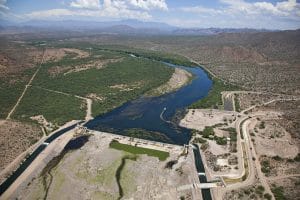Summary
The Water and Environmental Technology Center, an Industry/University Collaborative Research Center at Arizona State University, has been working with regional water providers, such as the Salt River Project and Central Arizona Project, and with Phoenix metropolitan area cities for more than 25 years to monitor water quality parameters affecting drinking water supplies, treatment and distribution, including algae-related issues .This work has: 1) improved our understanding of the occurrence, control and treatment of various taste & odor compounds (e.g., methyl-isoborneol and geosmin); 2) improved our understanding of dissolved organic and algae dynamics; and 3) supported a forum to discuss and address regional water quality issues. This monitoring program benefits local water treatment plants by optimizing ongoing operations and reducing operating cost, improving the quality of municipal water for consumers, facilitating long-term water quality planning, and providing information on future-regulated compounds. We have been monitoring water quality in terminal reservoirs that provide our water since 1998. Additional monitoring has been conducted in water supply canal systems and in water treatment plants in Phoenix, Chandler, Peoria, Tempe, and Scottsdale. During this time, the Valley has experienced both prolonged droughts and above-average wet years. These data provide an important baseline for the development of new or expanded water treatment protocols and the management of treatment plants.
We analyze samples for algae-related constituents, taste and odor compounds, nutrients, and disinfection by-product precursors. In addition, microbial pathogens and indicators such as Mycobacterium, Legionella, E. coli, and coliforms are monitored to provide continued insight into the microbial profiles and dynamics of water quality parameters in source and treated waters.
Reservoir monitoring is conducted at Bartlett Lake, Saguaro Lake and Lake Pleasant, Roosevelt Lake, Apache Lake, and Canyon Lakes. Samples are depth-integrated in the epilimnion and hypolimnion. CAP collects samples from Lake Pleasant. SRP collects samples from Bartlett, Saguaro, Roosevelt, Apache and Canyon Lakes. Field measurements for temperature with depth have also been collected. The lake sampling can provide early warning information on potentially large changes in water quality due to algae production, lake destratification and forest fires or other runoff events. River samples from the Salt River below Saguaro Lake at Blue Point Bridge and from the Verde River at the Beeline Highway are collected once per month. Canal monitoring includes the CAP, Arizona, and South canals at multiple locations. The purpose of the canal sampling is to identify hot spots of production of taste and odor compounds and to make recommendations to the cities, SRP, and CAP to perform necessary canal maintenance and treatment.
A quarterly newsletter with summary of the results are provided to the WET Center members and the Project’s supporting team. Please contact Professor Abbaszadegan, Director of WET Center at [email protected] for additional information.
